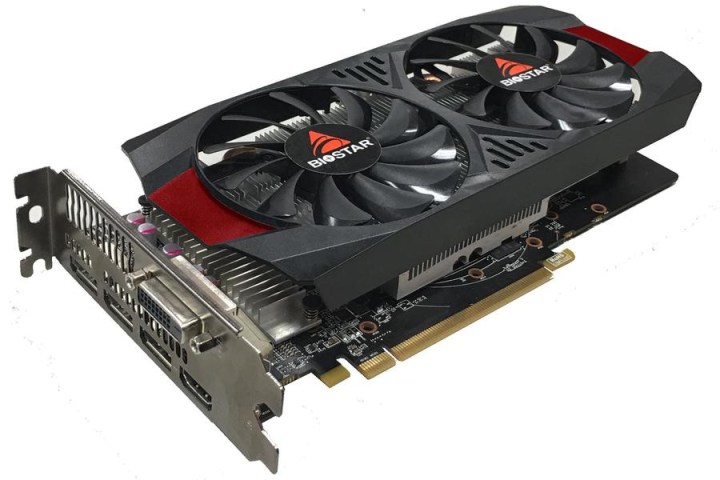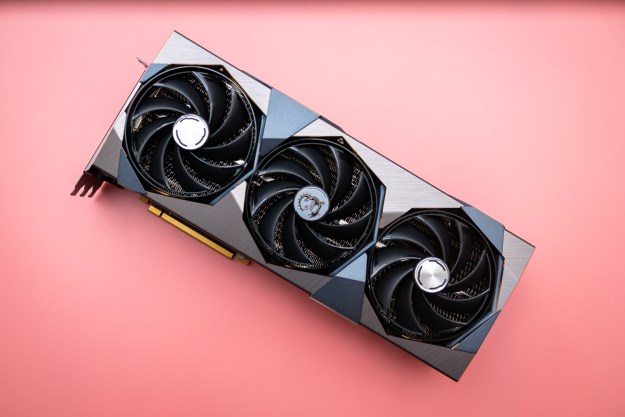
That said, these cards are built to run 24 hours a day, seven days a week. That means AMD, Nvidia, and their partners had to go back to the drawing board to provide long-lasting products built with high endurance components to handle the the ongoing cryptocurrency mining process. From what we’ve found so far, most will not have video output, which makes sense given their dedication to digital currency mining.
That all said, we’ve broken our list into two sections: listed products, and cards that are supposedly hitting the market over the next two months. Ready to find your next graphic card for mining?
Listed Products
Asus
Asus was one of the first companies to list cryptocurrency mining cards on its website. The company provides one AMD-based and one Nvidia-based graphics card for mining, although at the time of this writing, these products aren’t listed for sale through online retailers. Note that the AMD-based card does have a single DVI-D video output while the Nvidia-based card has no video interface. Both models include dual-ball bearing fans, support for GPU Tweak II, and IP5X-certified dust resistance.
| Card Name | Base Speed | Boost Speed | Memory | Video Output | Price |
| Mining-RX470-4G | 926MHz | 1,206MHz | 4GB @ 7,000MHz | Yes (1) | ? |
| Mining-P106-6G | 1,506MHz | 1,708MHz | 6GB @ 8,008MHz | No | $226? |
Biostar
Currently, Biostar lists only one graphics card for mining. This is the only card in our batch of cryptocurrency mining cards that has more than one video output: one DVI-D port, one HDMI port, and one DisplayPort connector. The base speed is unknown for now along with the card’s prictag and availability.
| Card name | Base Speed | Boost Speed | Memory | Video | Price |
| VA47D5RV42 (Mining) | ? | 1,200Mhz | 4GB @7000MHz | Yes (3) | ? |
Manli
This company sells two graphics cards dedicated to cryptocurrency mining based on the Nvidia GeForce GTX 1060 chip. They appear to be identical save for their overall size, as the F347G unit is slightly larger than the other. According to Manli, both cards have an Ethereum hash rate of 23 mega-hashes (MH) per second or more. They also use 100 watts while Ethereum mining.
| Card Name | Base Speed | Boost Speed | Memory | Video Output | Price |
| P106-100 Mining Card (F336G) |
1,506MHz | 1,708MHz | 6GB @ 8,008MHz | No | ? |
| P106-100 Mining Card (F347G) |
1,506MHz | 1,708MHz | 6GB @ 8,008MHz | No | ? |
MSI
Online retailer NCIX shows that MSI is gearing up to release a graphics card for mining based on the GTX 1060 graphics chip. However, the product listing provides absolutely no detail outside the name and estimated price. There’s also supposedly a version in the works based on the GTX 1070 or GTX 1080 with 8GB of on-board memory. Presumably these cards will not have video output.
| Card Name | Base Speed | Boost Speed | Memory | Video Output | Price |
| P106-100 Miner 6G | ? | ? | 6GB | ? | $348 |
| P104-100 Miner 8G | ? | ? | 8GB | ? | ? |
Sapphire
This company doesn’t list it’s heaping cryptocurrency mining cards on its website. Instead, they can be found on Newegg and Overclockers. All listed models are based on the Radeon RX 470 GPU save for one graphics card for mining relying on the Radeon RX 560. Even more, one pair is based on memory provided by Samsung while the second pair does not, thus you’ll see a slight price difference between the two sets. All Radeon RX 470 models have the same GPU and memory speeds, although Sapphire isn’t listing their base speed on the product listings.
| Card Name | Base Speed | Boost Speed | Memory | Video Output | Price |
| Radeon RX 470 Mining Edition 8GB (11256-38-10G) |
? | 1,236MHz | 8GB @ 7,000MHz (Samsung) |
No | $386 |
| Radeon RX 470 Mining Edition 4GB (11256-36-10G) |
? | 1,236MHz | 4GB @ 7,000MHz (Samsung) |
No | $334 |
| adeon RX 470 Mining Edition 8GB (11256-37-10G) |
? | 1,236MHz | 8GB @ 7,000MHz (Non-Samsung) |
No | $373 |
| Radeon RX 470 Mining Edition 4GB (11256-35-10G) |
? | 1,236MHz | 4GB @ 7,000MHz (Non-Samsung) |
No | $320 |
| Radeon RX 470 Mining Edition 4GB (11256-21-21G) |
? | 1,236MHz | 4GB @ 7,000MHz (Non-Samsung) |
Yes (1) | $250 |
| Radeon RX 470 Mining Edition 4GB (11256-31-21G) |
? | 1,236MHz | 4GB @ 7,000MHz (Non-Samsung) |
Yes (1) | $260 |
| Radeon RX 560 Pulse Mining Edition 4GB (11267-11-10G) |
? | 1,300MHz | 4GB @ 7,000MHz (Non-Samsung) |
Yes (1) | $219 |
Zotac
Right now, Zotac only lists one graphics card for mining. The specifications state that this card doesn’t support video output, but product images show a physical DVI-D connector. There’s also spaces for one HDMI port and a DisplayPort connector, although they’re not physically present. Other than that, the card’s name listed below stems from Google Translator, so don’t expect Zotac to sell a card based on “nuggets.” North American details have not been released, so expect a better name when (or if) that happens.
| Card Name | Base Speed | Boost Speed | Memory | Video Output | Price |
| Sauter P106-100 Nuggets | 1,506MHz | 1,708MHz | 6GB @ 8,008MHz | No | ? |
What’s (Probably) Coming
The remaining four cards on our roundup aren’t listed on any online retailer or manufacturer website. Instead, we’ve provided a batch of cards rumored to be arriving within the next several months. These include one from Colorful, one from EVGA, and two from Inno3D. We will add more to this section as other rumored cards surface.
Colorful
Model: P106-100 WK1/WK2
Base speed: 1,506MHz
Boost speed: 1,708MHz
Memory amount: 6GB
Memory speed: 8,008MHz
Video output: None
Size: 8.66 x 4.92 x 1.57 inches
EVGA
Model: GTX 1060 6G P106 Miner Edition
Base speed: 1,506MHz
Boost speed: 1,708MHz
Memory amount: 6GB
Memory speed: 8,008MHz
Video output: None
Size: Dual-slot
Inno3D
Model: P106-100 Compact
Base speed: 1,506MHz
Boost speed: 1,708MHz
Memory amount: 6GB
Memory speed: 8,008MHz
Video output: Unknown
Size: Dual-slot (6.77 inches long)
Model: P106-100 Twin X2
Base speed: 1,506MHz
Boost speed: 1,708MHz
Memory amount: 6GB
Memory speed: 8,008MHz
Video output: Unknown
Size: Dual-slot (8.58 inches long)
Editors' Recommendations
- 11 best graphics cards of 2024: the GPUs I’d recommend to any PC gamer
- AMD’s canceled GPU could have crushed Nvidia
- Intel may fire the first shots in the next-gen GPU war
- GPU prices are back on the rise again
- The sad reality of AMD’s next-gen GPUs comes into view



